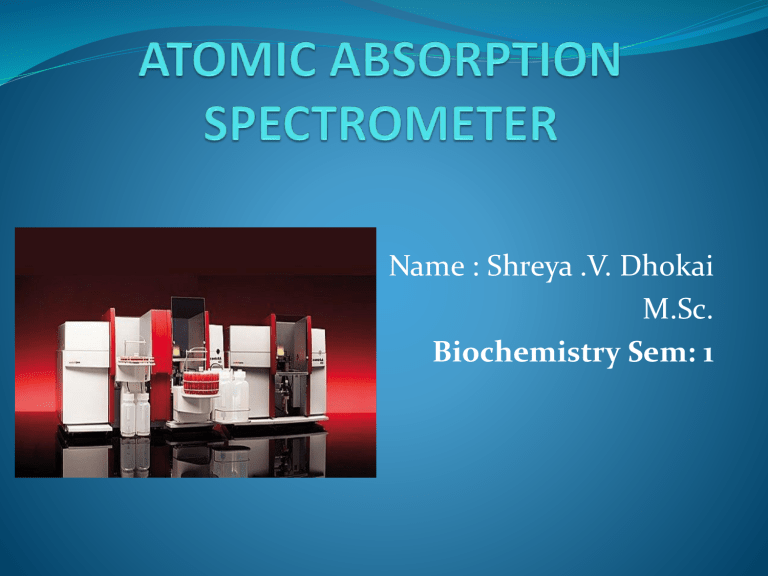
Name : Shreya .V. Dhokai M.Sc. Biochemistry Sem: 1 ATOMIC ABSORPTION SPECTROMETER Introduction Invention Working Principle of AAS Instrumentation Interferences Applications INVENTION Introduced in 1955 by Alan Walsh in Australia Firstly used for mining, medical treatment&agriculture Alan Walsh(1916-1998) PROPERTIES OF AAS The most widely used method in analysis of elements Based on the absorption of radiation So sensitive (ppb) Quantitative analysis WORKING PRINCIPLE OF AAS Electrons promote to higher orbitals for a short amount of time by absorbing a energy M + hv → M* Relises on Beer-Lambert Law A= a.b.c INSTRUMENTATION LIGHT SOURCES Hollow Cathode Lamps Anode-Tungsten wire Cathode made from the element of interest (Na,K,Ca..) Argon or neon gas LIGHT SOURCES Electrodeless Discharge Lamp Typically argon gas at low pressure ATOMIZATION Compounds making up the sample are broken into free atoms. High temperature is necessary Basic two types -Flame atomizer -Electrothermal atomizer TYPES OF ATOMIZERS FLAME ATOMIZER Simplest atomization Converts analyte into free atoms of vapor phase Flammable &caustic gases Not has an inert medium (−) Short analysis time (−) TYPES OF ATOMIZERS ELECTROTHERMAL ATOMIZER A cylindirical graphite tube Inert gas medium (Argon gas) Longer anlaysis time than flame Superior sensitivity, high accuracy MONOCHROMATOR Also it is called wavelengh selector Select the specific wavelenght Polychromatic light →monochromatic light Simple one is enough for AAS DETECTOR Electromagnetic waves → electric current The most used one Photomultiplier tube Have fast response times CALIBRATION TECHNIQUES • Two main techniques Calibration curve method Standart addition method CALIBRATION TECHNIQUES CALIBRATION CURVE METHOD Draw a graph Have two or more variables -One is set at known values -One is measured response Most convenient for a large number of similar samples analysis. CALIBRATION TECHNIQUES CALIBRATION TECHNIQUES STANDART ADDITION METHOD To measure the analyte concentration in a complex matrix. Most convenient for small number of samples analysis Prevent effect of chemical & spectral interferences INTERFERENCES Causes higher or lower absorbance value Two major groups Chemical Interferences Spectral Interferences CHEMICAL INTERFERENCES The most common one in flame atomizer. Consequence of chemical reactions. Reduce amount of oxygen in flame to overcome SPECTRAL INTERFERENCES Absorption or emission of the radiation at the same wavelength Radiation which is absorbed→positive errors Radiation which is emmitted→negative errors CONCLUSION One of the most important technique in quantitative analysis It is based on the absorption of radiation Measurements could be done at ppb levels It’s widely used method The preparation of the sample is usually simple and rapid CONCLUSION There are many advantages High sensitivity [10-10 g (flame), 10-14 g (non-flame)] Good accuracy (Relative error 0.1 ~ 0.5 % ) High selectivity APPLICATIONS OF AAS Water analysis (e.g. Ca, Mg, Fe, Si, Al, Ba content) Food analysis Analysis of animal feedstuffs (e.g. Mn, Fe, Cu, Cr, Se,Zn) Analysis of soils Clinical analysis (blood samples: whole blood, plasma,serum; Ca, Mg, Li, Na, K, Fe) REFERENCES http://www.scribd.com/doc/10513921/Atomic- Absorption-Determination-of-Zinc-and-Copper-in-aMultivitamin http://www.hemlin.pp.se/USstarten.html http://www.learn-english-today.com/businessenglish/presentations-phrases.htm THANK YOU


